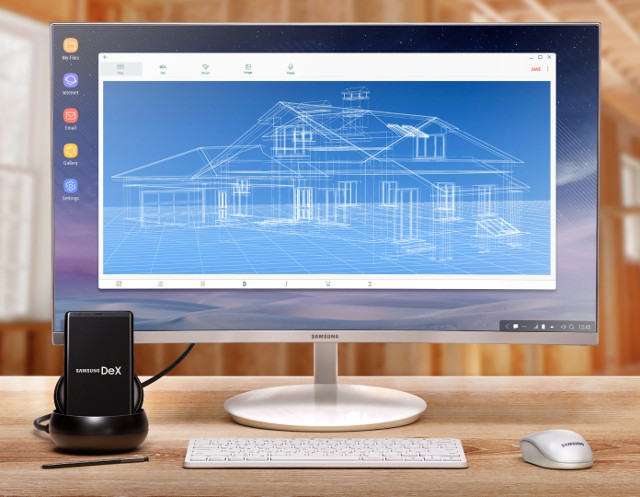Earlier this year, Linux desktop mobile convergence took a serious hit when Canoncial decided to drop support for Unity and Mobile Convergence in their Ubuntu distributions, focusing instead on the enterprise and IoT market, and replacing Unity by GNOME starting with the just released Ubuntu 17.10.
Things started to look better with Purism Librem 5 Linux smartphone, which has now raised $1.8 million dollars, and partnered with well-known members of the Linux ecosystems like KDE, GNOME, and NextCloud. However, the phone will be based on a rather low end NXP i.MX 8M quad Cortex A53 SoC, is scheduled for January 2019 only, and being a crowdfunding campaign, failure is always a possibility.
But today, the outlook for Linux phones brightened even more, as Samsung unveiled plans for “Linux on Galaxy” at the Samsung Developer Conference 2017.

The solution will leverage the company’s DeX (Desktop Experience) that relies on DeX Station – a dock for Samsung Galaxy S8, S8+, and Note8 smartphone – that connected to a big display, as well as a special Android desktop mode that supports multi-window, comes with a start menu, etc…
Linux on Galaxy app will enable developers and users to leverage Samsung DeX hardware (station + smartphone) to run their preferred Linux desktop distribution(s) using the same kernel that powers Android OS. For example, developers will be able to code using their mobile on-the-go, and with Samsung DeX, continue their work on a larger display.
Samsung Linux on Galaxy is still a work in progress, and the project is still private. But if you are interested, you can register your interest in order to get notified when it goes public.

Jean-Luc started CNX Software in 2010 as a part-time endeavor, before quitting his job as a software engineering manager, and starting to write daily news, and reviews full time later in 2011.
Support CNX Software! Donate via cryptocurrencies, become a Patron on Patreon, or purchase goods on Amazon or Aliexpress





“..Linux desktop distribution(s) using the same kernel that powers Android OS.”
That’s what Canonical did. On one hand, it allowed a working GPU stack (via libhybris). On the other, that GPU stack, along with the entire useland, was stuck with a kernel version for eternity. Also, Canonical insisted on an armhf (32bit) userspace, so users doing 64bit on armv8 hw had to go through unnecessary hoops. Let’s hope Samsung don’t repeat that mistake.
Correct me if I’m wrong, but libhybris is there due to Android userland choices, like bionic instead of libc, armel instead of armhf and maybe others. So if you take native GPU driver, libhybris in unnecessary. I guess Samsung can do that, since it is SoC and board designer and should have access to GPU userspace driver source.
It looks like Moto Webtop OS first version.
Webtop OS ended by being killed by Google.
@jernej
You’re right – Canonical used libhybris for interfacing Linux userland to Android userland. So I should have formulated it better as: Canonical used Android kernels and Android GPU stacks with libhybris bridging to Linux userland. And yes, you’re also right that if a vendor has full control of the GPU stack, they should be able to provide such a stack to native Linux. But hey, if they have control over the SoC they should also be able to provide up-to-date linux kernel support!.. So let’s see how Samsung proceed.
Well, the Android desktop have more applications, I think Android desktop is more useful than linux desktop.
Um, more useful than linux?
@jacky
They already have an Andorid desktop – DeX does that already.
This sounds brilliant and if Samsung ships it officially, they will certainly have a buyer that would have bought anew phone from an other mfg.
Samsung being a Wayland contributor and having a full-Linux phone OS, this could have come earlier.
I am waiting when I will be able to run a full blown VM on my phone.
Can’t understand why is that taking so long, CPUs already support virtualization, I wan’t my Linux in qemu!
Manufacturer’s kernels are full of crap from crap SDKs, who wants that?
@kdayns Because shitty vendors like Samsung “lock down” the VE to run their own crappy “security software” in EL2 (along with other shitty software in EL3)
am I the only one happy to know Unity support is over? I prefer robust desktop even if that means old like hell than fancy bullshit. I always disable Aero in windows, I want it to look the closest to windows 2000 as possible to make it as fast as it can be. That’s why old looking without any effects will always be better 🙂
Ubuntu 16.04 running on Samsung phone + Dex docking station:
https://youtu.be/vm1xHnvYIdc
@Jean-Luc Aufranc (CNXSoft)
Finally. So far Samsung seem to avoiding some of the mistakes Canonical made, e.g. this time it’s a proper arm64 distro.